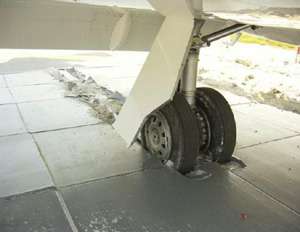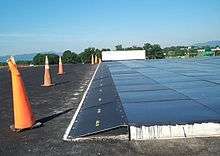Engineered materials arrestor system

An engineered materials arrestor system, engineered materials arresting system (EMAS), or arrester bed[1] is a bed of engineered materials built at the end of a runway. Engineered materials are defined in FAA Advisory Circular No 150/5220-22A as "high energy absorbing materials of selected strength, which will reliably and predictably crush under the weight of an aircraft". While the current technology involves lightweight, crushable concrete blocks, there is no regulatory requirement that this material be used for EMAS. The purpose of an EMAS is to stop an aircraft overrun with no human injury and minimal aircraft damage. The aircraft is slowed by the loss of energy required to crush the EMAS material. An EMAS is similar in concept to the runaway truck ramp made of gravel or sand. It is intended to stop an aircraft that has overshot a runway when there is an insufficient free space for a standard runway safety area (RSA). Multiple patents have been issued on the construction and design on the materials and process.
FAA Advisory Circular 150/5220 explains that an EMAS may not be effective for incidents involving aircraft of less than 25,000 pounds weight.[2] It also clarifies that an EMAS is not the same as a stopway, which is defined in FAA Advisory Circular 150/5300-13A, Section 312.[3]
United States installations


The FAA's design criteria for new airports designate Runway Safety Areas (RSA), to increase the margin of safety if an overrun occurs, and to provide additional access room for response vehicles. A United States federal law requires that the length of RSA in airports is to be 1,000 feet (300 m) by the end of 2015 in a response to a runway overrun into a highway at Teterboro Airport in New Jersey.[1] At airports built before these standards were put into effect, the FAA has begun funding the installation of EMAS at the ends of the main runways. As of July 2014, 47 United States airports had been so equipped; the plan was to have 62 airports so equipped by the end of 2015.[5] The minimum recommended overall length of an EMAS installation is 600 feet (180 m), of which at least 400 feet (120 m) is to consist of the frangible material.[6]
As of August 2015, over 100 EMAS have been installed.
Approved manufacturers
As of October 2014, there were two manufacturers of EMAS products that meet the FAA requirements of advisory circular 150-5220-22B, “Engineered Materials Arresting Systems for Aircraft Overruns.” The FAA must review and approve each EMAS installation .
Runway Safe EMAS is a foamed silica bed made from recycled glass and is contained within a high-strength plastic mesh system anchored to the pavement at the end of the runway. The foamed silica is poured into lanes bounded by the mesh and covered with a poured cement layer and treated with a top coat of sealant.[7]
There is a third manufacturer, certified by the Chinese CAAC with a product that is very similar to the original one of Zodiac ESCO.
Incidents
On 20 August 2014, the FAA issued a summary citing nine incidents of aircraft stopped by EMAS, involving a total of 243 passengers and crew:[8]
- In May 1999, a Saab 340 commuter aircraft with 30 persons aboard overran the runway at JFK.
- In May 2003, a Gemini Cargo MD-11 cargo aircraft with 3 persons aboard overran the runway at JFK.
- In January 2005, a Boeing 747 cargo aircraft with 3 persons aboard overran the runway at JFK.
- In July 2006, a Mystere Falcon 900 business aircraft with 5 persons aboard overran the runway at Greenville Downtown Airport in South Carolina.
- In July 2008, an Airbus A320 commercial airliner with 145 persons aboard overran the runway at Chicago's O'Hare Airport.
- On 19 January 2010, a Bombardier CRJ-200 commercial regional airliner with 34 persons aboard overran the runway at Yeager Airport in Charleston, West Virginia after a rejected takeoff.[9]
- On 1 October 2010, a G-4 Gulfstream business aircraft with 10 persons aboard overran the runway at Teterboro Airport in Teterboro, New Jersey.[10]
- On 2 November 2011, a Cessna Citation II business aircraft with 5 persons aboard overran the runway at Key West International Airport in Key West, Florida.[11][12]
- In October 2013, a Cessna 680 Citation business aircraft with 8 persons aboard overran the runway at Palm Beach International in West Palm Beach, Florida.
- In January 2016, a Dassault Falcon 20 business aircraft with 2 persons aboard overran the runway at Chicago Executive Airport, Illinois.
In addition, the following incidents have been described in other news outlets:
- After the 8 December 2005 overshoot of Southwest Airlines Flight 1248 at Midway International Airport in Chicago, Illinois, which is located in a heavily congested area, an EMAS was installed on Rwy 13C/31C.[13]
- On 13 October 2006, New York Yankees Alex Rodriguez's private jet was brought to a halt safely by the EMAS installation at Bob Hope Airport in Burbank, California. The system was installed after the 2000 Southwest Airlines Flight 1455 runway overshoot that injured 43 passengers and the captain.[14]
- On 27 October 2016, a chartered Boeing 737 carrying Republican Vice-Presidential Candidate Mike Pence, skidded off a runway at LaGuardia Airport in New York City and was slowed by EMAS.[15][16][17]
See also
References
- 1 2 Boburg, Shawn (17 September 2013). "Teterboro Airport gets $1M for runway project". northjersey.com. Retrieved 5 May 2014.
- ↑ FAA Advisory Circular 150/5220-22B (PDF)
- ↑ FAA Advisory Circular 150/5300-13A (PDF)
- 1 2 Jacobs, Kenneth (1 March 2006). "Runway Safety Areas - An Airport Operator's Perspective". Federal Aviation Administration. pp. 8, 9, 13. Archived from the original on 27 September 2012. Retrieved 20 August 2014.
- ↑ Runway Risk, Flying, September 2014 issue, p. 57
- ↑ FAA AC 150-5220
- ↑ FAA Fact Sheet – Engineered Material Arresting System (EMAS)
- ↑ FAA Fact Sheet
- ↑ "PSA Airlines Canadair CRJ-200 N246PS operating as US Airways flight 2495 from Charleston, West Virginia (CRW) to Charlotte, North Carolina (CLT) with 30 passengers [sic] and 3 crew, overran the runway following a rejected take-off. The aircraft was stopped by the EMAS at the end of the runway, sustaining only minor damage to its landing gear doors."
- ↑ "Private jet overshoots runway at Teterboro Airport". Archived from the original on 29 March 2012. Retrieved 28 October 2016.
- ↑ "A Cessna Citation landed at Key West. The flight, which originated in Fort Lauderdale with 3 passengers and 2 crew, had a brake failure upon landing in Key West and was successfully stopped by the airport's newly installed EMAS. Only minor injuries were reported."No one is hurt after small plane crash lands at Key West Airport". NJ.com. 4 November 2011. Retrieved 24 August 2012.
- ↑ "Aviation Accident Brief ERA12IA060". NTSB.
- ↑ "KMDW Airport Diagram" (PDF). Retrieved 7 January 2008.
- ↑ Oldham, Jennifer (14 October 2006). "Yankee Player's Jet Overruns Runway in Burbank". Los Angeles Times.
The airport installed the $4-million safety system after a Southwest Airlines Boeing 737 skidded off the same runway and onto a street in 2000, injuring 43 passengers and the captain on the same runway.
- ↑ Mele, Christopher (2016-10-27). "Plane With Mike Pence Aboard Skids Off La Guardia Runway". The New York Times. ISSN 0362-4331. Retrieved 2016-10-28.
- ↑ Walker, Karen (2016-10-27). "LaGuardia runway EMAS saves US VP candidate aircraft". Air Transport World. Retrieved 2016-10-29.
- ↑ Hradecky, Simon. "Accident: Eastern Air Lines B737 at New York on Oct 27th 2016, overran runway on landing long". avherald.com. Retrieved 2016-10-30.
External links
- EMAS at The FAA website
- Gulfstream II stopped by EMAS at Burbank
- ESCO site explaining EMAS with pictures
- Patent No. 6,726,400; Vehicle arresting bed systems
- Patent No. 5,902,068; Vehicle arresting unit fabrication methods
- Patent No. 5,885,025; Vehicle arresting bed systems
- Patent No. 5,789,681; Arresting material test apparatus and methods